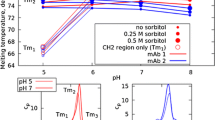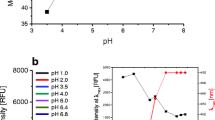Abstract
Purpose
The impact of ions on protein aggregation remains poorly understood. We explored the role of ionic strength and ion identity on the temperature- and agitation-induced aggregation of antibodies.
Methods
Stability studies were used to determine the influence of monovalent Hofmeister anions and cations on aggregation propensity of three IgG2 mAbs. The CH2 domain melting temperature (T m1) and reduced valence (z*) of the mAbs were measured.
Results
Agitation led to increased solution turbidity, consistent with the formation of insoluble aggregates, while soluble aggregates were formed during high temperature storage. The degree of aggregation increased with anion size (F− < Cl− < Br− < I− < SCN− ~ ClO4 −) and correlated with a decrease in T m1 and z*. The aggregation propensity induced by the anions increased with the chaotropic nature of anion. The cation identity (Li+, Na+, K+, Rb+, or Cs+) had no effect on T m1, z* or aggregation upon agitation.
Conclusions
The results indicate that anion binding mediates aggregation by lowering mAb conformational stability and reduced valence. Our observations support an agitation-induced particulation model in which anions enhance the partitioning and unfolding of mAbs at the air/water interface. Aggregation predominantly occurs at this interface; refreshing of the surface during agitation releases the insoluble aggregates into bulk solution.









Similar content being viewed by others
References
Y. B. Zhang, J. Howitt, S. McCorkle, P. Lawrence, K. Springer, and P. Freimuth. Protein aggregation during overexpression limited by peptide extensions with large net negative charge. Protein Expr. Purif. 36:207–216 (2004). doi:10.1016/j.pep.2004.04.020.
E. R. LaVallie, E. A. DiBlasio, S. Kovacic, K. L. Grant, P. F. Schendel, and J. M. McCoy. A thioredoxin gene fusion expression system that circumvents inclusion body formation in the E. coli cytoplasm. Bio/technology (Nature Publishing Company). 11:187–193 (1993).
E. D. Clark. Protein refolding for industrial processes. Curr. Opin. Biotechnol. 12:202–207 (2001). doi:10.1016/S0958-1669(00)00200-7.
W. Wang, S. Singh, D. L. Zeng, K. King, and S. Nema. Antibody structure, instability, and formulation. J. Pharm. Sci. 96:1–26 (2007). doi:10.1002/jps.20727.
J. R. Alford, B. S. Kendrick, J. F. Carpenter, and T. W. Randolph. High concentration formulations of recombinant human interleukin-1 receptor antagonist: II. Aggregation kinetics. J. Pharm. Sci. 97:3005–3021 (2008). doi:10.1002/jps.21205.
S. Kiese, A. Papppenberger, W. Friess, and H. C. Mahler. Shaken, not stirred: mechanical stress testing of an IgG1 antibody. J. Pharm. Sci. 97:4347–4366 (2008). doi:10.1002/jps.21328.
A. S. Rosenberg. Effects of protein aggregates: an immunologic perspective. AAPS J. 8:E501–E507 (2006). doi:10.1208/aapsj080359.
H. A. Lehr, J. Brunner, R. Rangoonwala, and C. J. Kirkpatrick. Particulate matter contamination of intravenous antibiotics aggravates loss of functional capillary density in postischemic striated muscle. Am. J. Respir. Crit. Care Med. 165:514–520 (2002).
R. L. Baldwin. How Hofmeister ion interactions affect protein stability. Biophys J. 71:2056–2063 (1996).
C. Tanford. Protein denaturation. Adv. Protein Chem. 23:121–282 (1968). doi:10.1016/S0065-3233(08)60401-5.
P. H. von Hippel, and K.-Y. Wong. Neutral salts: the generality of their effects on teh stability of macromolecular conformations. Science. 145:577–580 (1964). doi:10.1126/science.145.3632.577.
A. C. Dumetz, M. Snellinger-O’brien, A. E. W. Kaler, and A. M. Lenhoff. Patterns of protein protein interactions in salt solutions and implications for protein crystallization. Protein Sci. 16:1867–1877 (2007). doi:10.1110/ps.072957907.
S. Shima, C. Tziatzios, D. Schubert, H. Fukada, K. Takahashi, U. Ermler, and R. K. Thauer. Lyotropic-salt-induced changes in monomer/dimer/tetramer association equilibrium of formyltransferase from the hyperthermophilic Methanopyrus kandleri in relation to the activity and thermostability of the enzyme. Eur. J. Biochem. 258:85–92 (1998). doi:10.1046/j.1432-1327.1998.2580085.x.
Y. Zhangand, and P. S. Cremer. Interactions between macromolecules and ions: The Hofmeister series. Curr. Opin. Chem. Biol. 10:658–663 (2006). doi:10.1016/j.cbpa.2006.09.020.
W. Melander, and C. Horvath. Salt effect on hydrophobic interactions in precipitation and chromatography of proteins: an interpretation of the lyotropic series. Arch. Biochem. Biophys. 183:200–215 (1977). doi:10.1016/0003-9861(77)90434-9.
K. D. Collins. Sticky ions in biological systems. Proc. Natl. Acad. Sci. U. S. A. 92:5553–5557 (1995). doi:10.1073/pnas.92.12.5553.
K. D. Collins. Charge density-dependent strength of hydration and biological structure. Biophys. J. 72:65–76 (1997).
K. D. Collins. Ions from the Hofmeister series and osmolytes: effects on proteins in solution and in the crystallization process. Methods. 34:300–311 (2004). doi:10.1016/j.ymeth.2004.03.021.
M. W. Washabaugh, and K. D. Collins. The systematic characterization by aqueous column chromatography of solutes which affect protein stability. J. Biol. Chem. 261:12477–12485 (1986).
Y. R. Gokarn, A. Kosky, E. Kras, A. McAuley, and R. L. Remmele Jr. Excipients for protein drugs. In A. Katdare, and M. V. Chaubal (eds.), Excipient Development for Pharmaceutical, Biotechnology, and Drug Delivery Systems, Informa Healthcare USA, Inc., New York, 2006, pp. 291–340.
J. Liu, M. D. Nguyen, J. D. Andya, and S. J. Shire. Reversible self-association increases the viscosity of a concentrated monoclonal antibody in aqueous solution. J. Pharm. Sci. 94:1928–1940 (2005). doi:10.1002/jps.20347.
S. Kanai, J. Liu, T. W. Patapoff, and S. J. Shire. Reversible self-association of a concentrated monoclonal antibody solution mediated by Fab-Fab interaction that impacts solution viscosity. J. Pharm. Sci. 97:4219–4227 (2008). doi:10.1002/jps.21322.
Y. R. Gokarn, E. Kras, C. Nodgaard, V. Dharmavaram, R. M. Fesinmeyer, H. Hultgen, S. Brych, R. L. Remmele Jr., D. N. Brems, and S. Hershenson. Self-buffering antibody formulations. J. Pharm. Sci. 97:3051–3066 (2008). doi:10.1002/jps.21232.
E. Gasteiger, C. Hoogland, A. Gattiker, S. Duvaud, M. R. Wilkins, R. D. Appel, and A. Bairoch. Protein identification and analysis tools on teh ExPASy server. In J. M. Walker (ed.), The Proteomics Protocols Handbook. Humana Press, 2005.
J. A. Durant, C. Chen, T. M. Laue, T. P. Moody, and S. A. Allison. Use of T4 lysozyme charge mutants to examine electrophoretic models. Biophys. Chem. 101–102:593–609 (2002). doi:10.1016/S0301-4622(02)00168-0.
T. Laue, B. Shah, T. Ridgeway, and S. Pelletier. Analytical ultracentrifugation in biochemistry and polymer science. In S. Harding, A. Rowe, and J. Horton (eds.), Thomas Graham House, Cambridge, 1992, pp. 90–125.
P. Schuck. Size-distribution analysis of macromolecules by sedimentation velocity ultracentrifugation and lamm equation modeling. Biophys. J. 78:1606–1619 (2000).
R. L. Remmele Jr., S. D. Bhat, D. H. Phan, and W. R. Gombotz. Minimization of recombinant human Flt3 ligand aggregation at the Tm plateau: a matter of thermal reversibility. Biochemistry. 38:5241–5247 (1999). doi:10.1021/bi982881g.
V. M. Tischenko, V. M. Abramov, and V. P. Zav’yalov. Investigation of the cooperative structure of Fc fragments from myeloma immunoglobulin G. Biochemistry. 37:5576–5581 (1998). doi:10.1021/bi972647a.
J. Wen, Y. Jiang, and L. O. Narhi. Applications of DSC for Antiobodies and Fc-Conjugated Proteins. Am. Pharm. Rev. 10:10–15 (2007).
J. Wen, Y. Jiang, and L. O. Narhi. Effect of carbohydrate on thermal stability of antibodies. Am. Pharm. Rev. in press (2008).
J. P. Schmittschmitt, and J. M. Scholtz. The role of protein stability, solubility, and net charge in amyloid fibril formation. Protein Sci. 12:2374–2378 (2003). doi:10.1110/ps.03152903.
M. Calamai, N. Taddei, M. Stefani, G. Ramponi, and F. Chiti. Relative influence of hydrophobicity and net charge in the aggregation of two homologous proteins. Biochemistry. 42:15078–15083 (2003). doi:10.1021/bi030135s.
F. Chiti, M. Calamai, N. Taddei, M. Stefani, G. Ramponi, and C. M. Dobson. Studies of the aggregation of mutant proteins in vitro provide insights into the genetics of amyloid diseases. Proc. Natl. Acad. Sci. U. S. A. 99(Suppl 4):16419–16426 (2002). doi:10.1073/pnas.212527999.
Z. Ahmad, S. Yadav, F. Ahmad, and N. Z. Khan. Effects of salts of alkali earth metals and calcium chloride on the stability of cytochrome c and myoglobin. Biochim. Biophys. Acta. 1294:63–71 (1996).
G. I. Makhatadze, M. M. Lopez, J. M. Richardson 3rd, and S. T. Thomas. Anion binding to the ubiquitin molecule. Protein Sci. 7:689–697 (1998).
J. Kyte, and R. F. Doolittle. A simple method for displaying the hydropathic character of a protein. J. Mol. Biol. 157:105–132 (1982). doi:10.1016/0022-2836(82)90515-0.
P. Jungwirth, and D. J. Tobias. Specific ion effects at the air/water interface. Chem. Rev. 106:1259–1281 (2006). doi:10.1021/cr0403741.
B. A. Staggemeier, E. Bramanti, C. Allegrini, K. J. Skogerboe, and R. E. Synovec. High-throughput screening of protein surface activity via flow injection analysis-pH gradient-dynamic surface tension detection. Anal. Chem. 77:250–258 (2005). doi:10.1021/ac049088f.
S. Ghosal, J. C. Hemminger, H. Bluhm, B. S. Mun, E. L. Hebenstreit, G. Ketteler, D. F. Ogletree, F. G. Requejo, and M. Salmeron. Electron spectroscopy of aqueous solution interfaces reveals surface enhancement of halides. Science. 307:563–566 (2005). doi:10.1126/science.1106525.
N. B. Bam, J. L. Cleland, J. Yang, M. C. Manning, J. F. Carpenter, R. F. Kelley, and T. W. Randolph. Tween protects recombinant human growth hormone against agitation-induced damage via hydrophobic interactions. J. Pharm. Sci. 87:1554–1559 (1998). doi:10.1021/js980175v.
T. W. Randolph, and L. S. Jones. Surfactant-protein interactions. Pharm. Biotechnol. 13:159–175 (2002).
B. A. Kerwin. Polysorbates 20 and 80 used in the formulation of protein biotherapeutics: structure and degradation pathways. J. Pharm. Sci. 97:2924–2935 (2008). doi:10.1002/jps.21190.
R. H. Steele, S. Limaye, B. Cleland, J. Chow, and M. G. Suranyi. Hypersensitivity reactions to the polysorbate contained in recombinant erythropoietin and darbepoietin. Nephrology (Carlton, Vic.). 10:317–320 (2005).
K. S. Price, and R. G. Hamilton. Anaphylactoid reactions in two patients after omalizumab administration after successful long-term therapy. Allergy Asthma Proc. 28:313–319 (2007). doi:10.2500/aap.2007.28.3003.
M. J. Treuheit, A. A. Kosky, and D. N. Brems. Inverse relationship of protein concentration and aggregation. Pharm. Res. 19:511–516 (2002). doi:10.1023/A:1015108115452.
Acknowledgements
The authors would like to thank Prof. Thomas M. Laue and Ms. Susan Chase of the University of New Hampshire for their help with the reduced valence measurement method.
Author information
Authors and Affiliations
Corresponding author
Additional information
R. Matthew Fesinmeyer and Sabine Hogan have contributed equally to this work.
Rights and permissions
About this article
Cite this article
Fesinmeyer, R.M., Hogan, S., Saluja, A. et al. Effect of Ions on Agitation- and Temperature-Induced Aggregation Reactions of Antibodies. Pharm Res 26, 903–913 (2009). https://doi.org/10.1007/s11095-008-9792-z
Received:
Accepted:
Published:
Issue Date:
DOI: https://doi.org/10.1007/s11095-008-9792-z




